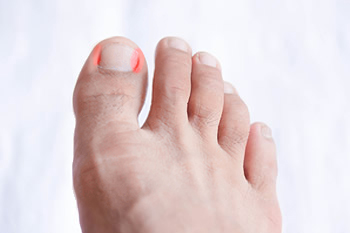(410) 764-7044
6506 Reisterstown Road, Baltimore
1205 York Road, Lutherville
6305 Belair Road, Baltimore
7809 Wise Avenue, Dundalk
Avoid Developing an Ingrown Toenail
Monday, 03 February 2020 00:00 As many patients know, having an ingrown toenail can be extremely painful, and can often make completing everyday activities more difficult. To help prevent developing this uncomfortable condition, it’s important that certain precautions are taken while cutting your toenails. The first step for proper trimming starts with your technique. Nails should be trimmed straight across, avoiding making them rounded. They should also be trimmed just enough that the corners loosely sit on the skin, and not too short where they begin to dig into the skin. You also want to make sure that the clippers you’re using to trim your nails are specifically designed for the purpose of trimming toenails. Some signs that may indicate you’ve developed an ingrown toenail can include redness surrounding the skin of the affected toe, swelling, pain, and in more severe cases, you may notice pus around the nail. In order to safely treat an ingrown toenail, we recommend you consult with a podiatrist for professional care and attention.
As many patients know, having an ingrown toenail can be extremely painful, and can often make completing everyday activities more difficult. To help prevent developing this uncomfortable condition, it’s important that certain precautions are taken while cutting your toenails. The first step for proper trimming starts with your technique. Nails should be trimmed straight across, avoiding making them rounded. They should also be trimmed just enough that the corners loosely sit on the skin, and not too short where they begin to dig into the skin. You also want to make sure that the clippers you’re using to trim your nails are specifically designed for the purpose of trimming toenails. Some signs that may indicate you’ve developed an ingrown toenail can include redness surrounding the skin of the affected toe, swelling, pain, and in more severe cases, you may notice pus around the nail. In order to safely treat an ingrown toenail, we recommend you consult with a podiatrist for professional care and attention.
Ingrown toenails may initially present themselves as a minor discomfort, but they may progress into an infection in the skin without proper treatment. For more information about ingrown toenails, contact one of our podiatrists of Plaza Podiatry. Our doctors can provide the care you need to keep you pain-free and on your feet.
Ingrown Toenails
Ingrown toenails are caused when the corner or side of a toenail grows into the soft flesh surrounding it. They often result in redness, swelling, pain, and in some cases, infection. This condition typically affects the big toe and may recur if it is not treated properly.
Causes
- Improper toenail trimming
- Genetics
- Improper shoe fitting
- Injury from pedicures or nail picking
- Abnormal gait
- Poor hygiene
You are more likely to develop an ingrown toenail if you are obese, have diabetes, arthritis, or have any fungal infection in your nails. Additionally, people who have foot or toe deformities are at a higher risk of developing an ingrown toenail.
Symptoms
Some symptoms of ingrown toenails are redness, swelling, and pain. In rare cases, there may be a yellowish drainage coming from the nail.
Treatment
Ignoring an ingrown toenail can have serious complications. Infections of the nail border can progress to a deeper soft-tissue infection, which can then turn into a bone infection. You should always speak with your podiatrist if you suspect you have an ingrown toenail, especially if you have diabetes or poor circulation.
If you have any questions, please feel free to contact our offices located in Baltimore, Lutherville, and Dundalk, MD . We offer the newest diagnostic and treatment technologies for all your foot care needs.




